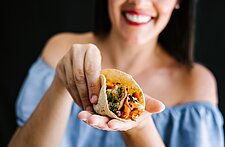Part 4 of 7
Ethnic Influences
If there was one word that stood out at the 8th annual International Chefs Congress (ICC) (http://www.starchefs.com/cook/events/icc/2013) held in New York City in late September, it was “Asian,” with “Spanish” as a close second, and “food cart-type meals” as a third. The overarching theme: Ethnic foods are pervading chef’s kitchens as they fuse a melting pot of cultures into their creations. Many chefs are also influenced by the street car food found on their international travels.
Inspiration from the Far East (or Asian Rules)
Kimchi, gouchujang, and miso are high on the list of ingredients chefs are using as are Szechuan peppercorns and yuzo. David Santos of Louro (http://www.louronyc.com/) (NYC) is currently working on his own version of umeboshi—Japanese pickled fruit—using apricots, peaches and cherries. Dany Mena is fusing the flavors of Mexico City at Sembrado (http://sembradonyc.com/) (NYC) with Asian influences with his enthusiasm for the versatility of yuzo. He’s also really into xoconostle, a cousin of the prickly pear that allows for several forms of acidity.
David Gilbert of Tuk Tuk Taproom (http://tuktuktaproom.com/) (San Antonio, TX) is so enamored with Southeast Asia that he flies in ingredients to ensure the food is really authentic. “I want the same subtle, good quality ingredients they are using,” he says. His dish at ICC: “Tod-mn-pla,” red curry Thai fish cake (made with flounder) served with a cucumber salad. He’s not alone. David Myers of Hinoki & the Bird (http://hinokiandthebird.com/) (Los Angeles, CA), brings in charcoal powder from Japan to help in the creation of a charcoal brioche used in his restaurant’s lobster roll. He also prefers using Japanese sweet potatoes as they hold the ingredients better after you roast them. In his opinion, both Tokyo and Kyoto are really pushing the envelope when it comes to food.
For others, all eyes are on Singapore where, according to Janice Wong of 2am Dessert Bar, the city is exploding with new restaurants. And then there’s the street food influences of Vietnam, Thailand, and China where, according to Gilbert, the idea is to pack a whole lot of flavor with simple ingredients.
Sourcing from Spain
On the Spanish side, Mena says chili, whether dried or fresh, is a big component in his kitchen while Dani Garcia, who is from the south of Spain, says he loves using “camarones” (baby shrimp), used often in Spanish cuisine, as they are packed with flavor. “The most important thing is flavor,” he stresses. “Technique should always be use service of taste.”
Many chefs note they are inspired by their travels. Before opening Sembrado, Mena traveled to Mexico City to stay true to the culinary roots. "With Spanish cuisine, it really depends where you go, because it's influenced by different regions, and they all tackle a dish somewhat differently. Where you find some places making authentic corn tortillas, you can go a few miles north (in Mexico) and find them using flour."
Guts and Glory 2013: Part 3 - Palatable Proteins
Guts and Glory 2013: Part 2 - The Sustainability Trend Continues
Guts and Glory 2013: Part 1 - Introduction & Overview





